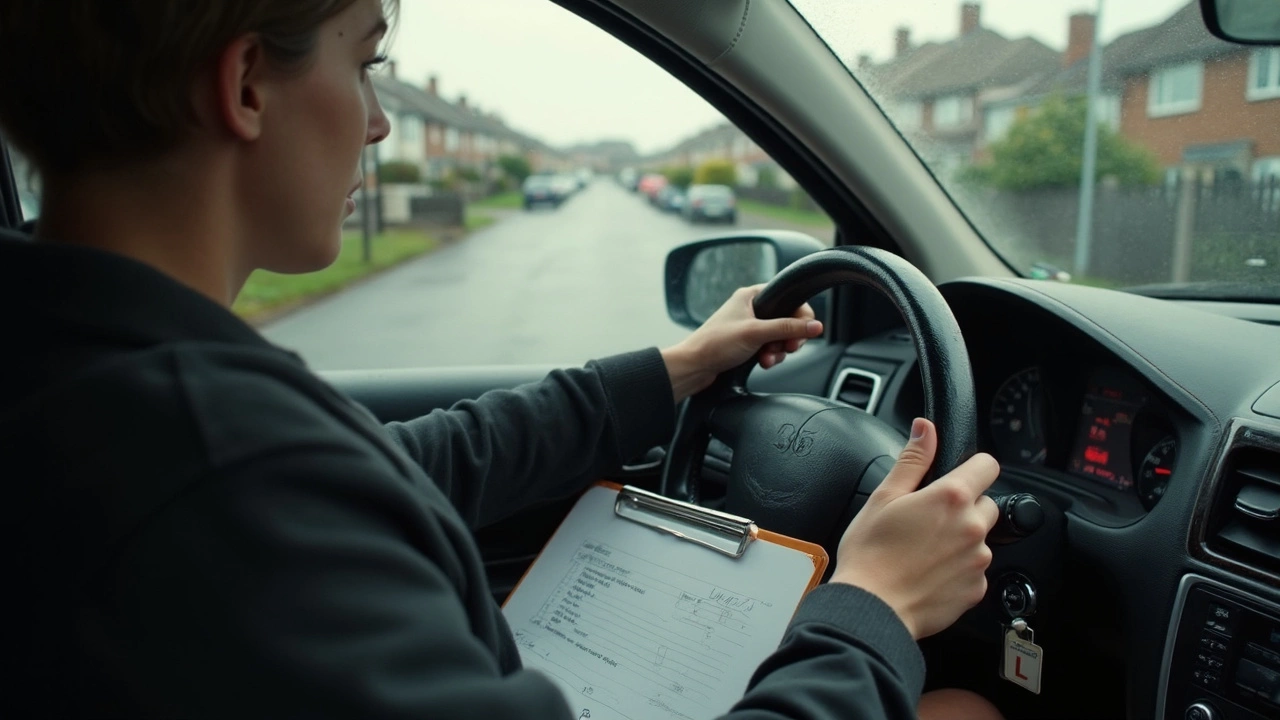You’re sitting in the driver’s seat and your palms already feel sweaty—yeah, the mock driving test can be way more stressful than people think. But here’s the deal: the mock test is your best shot at figuring out what the real thing will feel like—minus the risk of actually failing your license. If you take it seriously and treat it like the real deal, you’ll spot the silly mistakes you just don’t notice when your instructor is on your side.
The pass rate for first-time driving tests is lower than most folks expect, usually hovering around 47%. But guess what? Students who smash their mock tests tend to do better in the real exam because they know what to expect. Getting familiar with typical routes, the examiner’s instructions, and the timing of maneuvers can really settle your nerves.
So many people stumble on the basics: forgetting to check mirrors, speeding in 20 zones, or getting panicky at roundabouts. If you go into your mock test aiming to keep a clear head and steady pace, you’re halfway there already. Don’t treat it like just another practice drive—see it as your final dress rehearsal, and squeeze every last bit of feedback out of your instructor afterwards.
- What Happens in a Mock Driving Test?
- Most Common Mistakes (and How to Avoid Them)
- Practical Prep: Training Smarter, Not Just Harder
- Dealing with Nerves and Staying Focused
What Happens in a Mock Driving Test?
The mock driving test is basically set up to feel just like the real thing, minus the pressure of a stranger holding your fate. Usually, your regular instructor plays the part of the examiner and seriously—it’s meant to be strict. You can expect all the main parts of the actual driving exam: a safety check, general drive, one or two maneuvers, and a chunk focused on independent driving.
Most mock driving tests last around 40 minutes. They start with a ‘show me, tell me’ vehicle check question. Then you're off on the road, following instructions just like in the real deal. You might get asked to parallel park, pull up on the right and reverse, or even do a bay park if your test area includes it. The instructor gives no hints or friendly nudges like they usually do in lessons.
The order of the test is close to this:
- Show me, tell me vehicle safety questions
- General driving section on mixed roads
- One or two key maneuvers (chosen at random)
- Controlled stop (sometimes included)
- About 20 minutes of independent driving—following a sat nav or road signs
You don’t get your instructor’s clipboard, but you do get a feedback sheet afterwards showing every mark—minor, serious, or dangerous fault. It’s a wake-up call if you’re piling up the minor faults or missing something obvious.
Here’s what the scoring looks like for a UK-style test (your local area might differ, so ask your instructor):
| Fault Type | Description | How Many Allowed |
|---|---|---|
| Minor Fault | Small mistakes (e.g., forgetting a mirror check) | Up to 15 |
| Serious Fault | A mistake with potential danger | None allowed |
| Dangerous Fault | A mistake causing actual danger | None allowed |
According to the DVSA, "Taking a mock test is proven to help learners identify risky habits before the real exam." Here’s what one examiner says:
“Mock tests give the best reality check—learners usually spot two or three bad habits they never realized.”
Don’t be surprised if you feel more on edge in a mock test than in any lesson. That’s a good thing. Use it to build up your confidence, get used to the nerves, and learn how to stay cool even when your mind blanks out. Every bit of feedback you get here will set you up better for the real test day.
Most Common Mistakes (and How to Avoid Them)
Mistakes in a mock driving test can turn what feels like an easy drive into a disaster. And almost every learner falls into the same traps. If you know what to look out for, it’s way easier to avoid messing things up on the big day.
Here’s the brutal truth from the DVSA: in 2024, 35% of UK driving test fails were down to just five mistakes. Wondering what those are? Look at this:
| Common Mistake | Percentage of Fails Caused |
|---|---|
| Not checking mirrors before changing direction | 17% |
| Poor observation at junctions | 12% |
| Bad steering control | 9% |
| Failing to move off safely | 7% |
| Responding incorrectly to traffic lights | 6% |
It helps to have a checklist so you don’t join that statistic:
- Always check your mirrors and signal before making any maneuver. Make it obvious—examiners are watching your head, not just your eyes.
- When you approach junctions, slow down early, look both ways, and don’t rush into the road if you can’t see clearly.
- Keep both hands on the wheel as much as possible and steer smoothly. Over-correcting or grabbing at the wheel makes you look nervous.
- Take an extra second to look for bikes or pedestrians when moving off, especially after stopping at the side of the road.
- With traffic lights, don’t panic. If the light turns amber before you pass the stop line, stop (unless you’re literally on the line already).
Arlo once asked me, “Why do people forget easy stuff when they’re nervous?” Honestly, it’s about focus. You get so caught up in doing everything ‘by the book’ you blank out on the basics. If you feel your brain fogging up, take a deep breath—your instructor will probably tell you the same thing.
“The little things add up fast. Most learners who fail do so on basic errors—not dangerous driving. Pass rates jump for those who get the routine right, not just the tricky bits.” — Sarah Beckett, Senior Examiner, DVSA
Here’s a tip: ask your instructor to read out directions just like an examiner would. Practicing this will help you get used to listening while driving, which cuts down on silly mistakes. If you spot a pattern in your mock test blunders, tackle it head-on before your real test rolls around.

Practical Prep: Training Smarter, Not Just Harder
It’s tempting to just clock loads of hours behind the wheel and hope for the best, but that doesn’t guarantee success on your mock driving test. You need a game plan. That means figuring out where you slip up most and fixing those—not just driving in circles until you get tired.
First, ask your instructor if you can swap roles occasionally. Let them act like a real examiner, giving you no tips or gentle reminders. This helps you build up real decision-making, not just following someone else’s lead. According to the DVSA, the most common reasons for failing revolve around things that students ignore in regular practice—like hesitation at junctions or missing mirror checks.
Break down the tasks that give you trouble, like parallel parking or hill starts. Don’t just practice over and over—film yourself on your phone or get someone to watch. If you’re always drifting too close to the curb, you’ll spot it on camera way faster than just trying to remember what went wrong.
Make yourself a cheat sheet for tricky road signs and speed limits in the test area. Most towns have those sneaky 20mph zones with barely-there signs, and examiners love testing if you spot them. Drive your likely test routes as often as possible, but keep mixing it up so you don’t just memorize stops—you learn how to react for real.
- Simulate bad weather—drive in rain or when it’s dusky if you can, so nothing throws you off on test day.
- Work on your commentary driving: talk out loud when you check mirrors, signal, or approach hazards. Sounds silly, but it locks the habits in.
- Review all the feedback from your last mock, and don’t brush off low-priority faults—those add up fast in the real test.
Ask your instructor to give you a real-time score as you drive, just like the actual test. It’s eye-opening to see where you rack up minors and majors, and it feels way different than a regular lesson.
Sprint sessions work too—pick one maneuver at a time and keep at it for ten minutes straight, then switch. Keeps your mind sharp and stops you zoning out.
Dealing with Nerves and Staying Focused
Even the best-prepared drivers get shaky hands before a mock driving test. It’s normal—about 74% of learner drivers admit to feeling nervous, according to a 2024 UK survey. Nerves can make you forget what you know or mess up basic things like signaling and mirror checks. The key is turning that stress down so you can actually show what you can do when it matters.
One big trick is knowing what triggers those nerves. Loads of people freeze up if they feel watched, so ask your instructor to act exactly like an examiner—and keep the chat to a minimum so you learn to focus under silent pressure. Sound silly? Trust me, it helps you get used to the vibe of a real test.
Try out these hands-on ways to keep your brain in the game:
- Breathe slow and steady: If you feel jumpy at the start, take three deep breaths. Slow breathing hacks your body out of panic mode. Arlo picked it up before his test, and now he uses it before track meets too.
- Talk yourself through steps: There’s no shame in quietly muttering “mirrors, signal, maneuver.” It’s like having a checklist—Finley still says it out loud on bike rides.
- Have a practice routine: Pick a couple of routes you know are common test spots, and go over them until nothing surprises you.
- Cut out distractions: Ditch your phone, focus only on the road, and keep the inside of the car as clear as possible. Don’t let bags, bottles, or loose stuff roll around—you want a calm space.
People always ask, “Will nerves actually make me fail?” Well, take a look at this real data from recent UK mock tests:
| Reason for Test Mistake | % of Test Candidates |
|---|---|
| Nerves (shaky hands, mind blank) | 34% |
| Missed mirror/signal checks | 25% |
| Speeding from nerves | 18% |
| Wrong lane choice | 14% |
So, yeah, nerves matter—a lot. If you make a blunder, don’t dwell. Move on fast. Examiners don’t expect robots; they want someone who handles mistakes without falling apart. It’s like pressing ‘reset’ in your head and jumping to the next task. Stay in the moment, lock into your routine, and remember your practice. You’ve got this.

